- 1Department of Neuropsychiatry, Faculty of Medicine, Oita University, Oita, Japan
- 2Department of Neurosurgery, Faculty of Medicine, Oita University, Oita, Japan
- 3ATR Promotions, Brain Activity Imaging Center, Kyoto, Japan
Several studies have investigated neural correlates of aesthetic appreciation for paintings but to date the findings have been heterogeneous. This heterogeneity may be attributed to previous studies’ measurement of aesthetic appreciation of not only the beauty of paintings but also the beauty of motifs of the paintings. In order to better elucidate the beauty of paintings, it seems necessary to compare aesthetic appreciation of paintings and photographic analogs which included corresponding real images. We prepared for famous painters’ pictures and their photographic analogs which were set up to resemble each painting in order to investigate the hypothesis that there exist specific neural correlates associated with the aesthetic appreciation for paintings. Forty-four subjects participated in functional magnetic resonance study which required comparisons of aesthetic appreciation of paintings of still life and landscape versus photographic analogs including corresponding real images of still life and landscape. Bilateral cuneus and the left lingual gyrus were activated in the comparison of aesthetic appreciation of paintings versus photographic analogs. In conclusion, the present findings suggest a possibility of the existence of specific neural correlates associated with the aesthetic appreciation for paintings and that bilateral cuneus and the left lingual gyrus may be involved.
Introduction
Neuroaesthetics is a relatively young field within cognitive neuroscience, concerned with the neural underpinnings of aesthetic experience of beauty, particularly in visual art. Neuroscientific investigations have approached this area using imaging and neurophysiological techniques, such as functional magnetic resonance imaging (fMRI), magnetoencephalography (MEG) and electroencephalography (EEG), but the results produced so far are very heterogeneous (Cinzia and Vittorio, 2009). Brown et al. (2011) meta-analyzed 93 neuroimaging studies of aesthetic appraisal across four sensory modalities and showed that the most concordant area of activation across all four modalities is the right anterior insula, which reflects the “viscerality” of aesthetic perception. Although this meta-analysis revealed the activation of the right anterior insula, regarding the aesthetic appreciation of oil paintings, so far, the activation of the orbitofrontal cortex has been reported (Kirk, 2008; Kirk et al., 2009a,b; Ishizu and Zeki, 2011). Also, the activation of lingual gyrus has been shown (Kawabata and Zeki, 2004; Vartanian and Goel, 2004) while that of occipital gyri has been reported (Vartanian and Goel, 2004; Cupchik et al., 2009).
Such heterogeneity may be attributed to previous studies’ measurement of aesthetic appreciation of not only the beauty of paintings but also the beauty of motifs of the paintings, which is inevitably contained in the case of representational paintings. To elucidate the neural substrates involved in perceiving the beauty of representational paintings, it seems necessary to compare the beauty of the paintings of still life and landscape and that of real images (photographic analogs) which contain the same motifs as the paintings. Because the representational paintings with still life and landscape as their motifs can be reproduced faithfully as photographs by using the real materials or scenes, and hence both can evoke the same aesthetic feeling attributable to the beauty of motifs. Thus, contrasting these two conditions is expected to reveal the neural correlates specifically associated with the beauty of paintings with controlling the beauty of the motifs. To the best of our knowledge, Lacey et al. (2011) firstly compared paintings and photographic analogs where famous painters’ pictures and roughly resembling photographic analogs were used. In a different way, Vartanian and Goel (2004) have filtered each original painting to make a control condition such that the filtered pictures retained the overall form of the original paintings but lacked perceptual details, showing that the comparison of original paintings versus filtered paintings activated the right fusiform gyrus.
Hence, in the present study, we prepared for famous painters’ pictures and their photographic analogs which were set up to resemble each painting in order to investigate the hypothesis that there exist specific neural correlates associated with the aesthetic appreciation for paintings.
Materials and Methods
Subjects
Forty-four healthy subjects participated in the experiment but 5 subjects revealed artifacts. Therefore, 39 subjects’ data (mean age = 27.5 ± 5.7, 17 female) were submitted to analysis. Twenty-nine subjects were not interested in painting by themselves whereas the other 10 subjects were interested. The mean frequency of visiting museum was 0.76 times per year in the 29 subjects and 2.0 in the 10 subjects, respectively. All participants were right-handed and had normal or corrected to normal vision. They gave written informed consent to participate in this study according to procedures approved by the ethical committee at Oita University Faculty of Medicine.
Stimuli
Several days before imaging experiment, each subject slowly and carefully viewed 20 paintings of which contents were still life and land scape by famous painters such as Cezanne, Monet and so on. The 20 paintings were displayed on the table and ranked subjectively. Consequently, they were divided into 3 groups consisting of 5 paintings of the most beautiful, 10 paintings of more beautiful, and 5 paintings of not so beautiful by each subject. Thereafter, 5 paintings of the 10 paintings of more beautiful were randomly selected by the researcher (Y.M.). In sum, 15 paintings (5 of the most beautiful, 5 of more beautiful, and 5 of not so beautiful) were used for the following imaging experiment. Twenty photographs were taken in advance by the researcher (Y.M.) to imitate the 20 paintings as similarly as possible. Every effort was made to prepare similar motifs to imitate the corresponding paintings. Independently, the 20 photographic analogs were displayed on the table and ranked subjectively. These photographs (i.e., photographic analogs) were used as a control for the imaging experiment as shown in Figure 1. Since artistic paintings could not be used, the set of photographs of artistic paintings were used as Cela-Conde et al. (2009). It should be noted that the content of paintings and photographs were not the same across subjects and depended on individual subject’s aesthetic appreciation of the paintings. Moreover, there was no significant difference in luminance between paintings and photographs.
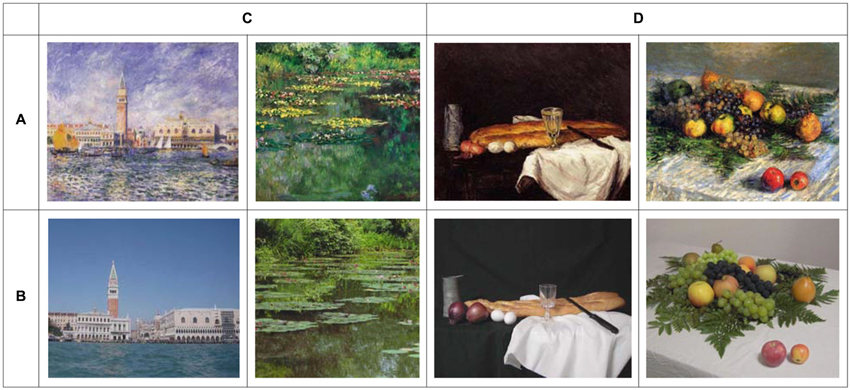
Figure 1. Example of painting and photographic analogs stimuli in this study. (A) Paintings (B) photographic analogs (C) landscape (D) still life.
Experimental Procedure
This study was block-design and all blocks had a sequence of 5 screens which consisted of paintings or photographic analogs. As shown in Figure 2, several experimental conditions/blocks were presented. Three painting blocks were presented to the subjects comprising the most beautiful (block A), more beautiful (block B) and not so beautiful (block C) while another 3 photographic analog blocks labeled A’, B’, and C’ were presented that corresponded to (or imitated) block A, B, and C, respectively. These visual stimuli were presented using Presentation (version 14.1) and projected via a forward projection system onto a translucent screen placed at the end of the magnet’s gurney. Subjects viewed the screen through a mirror attached to the head coil. Prior to each block, a fixation cross was presented for 20 s. The sequence of the presentation of the blocks was B, B’, A, A’, C, C’, B’, B, C’, C, A’, and A. Subjects were instructed as follows: “Please judge if the screen is beautiful or not by pressing the corresponding button”. It should be noted that there was no significant difference in luminance between paintings and photographs.
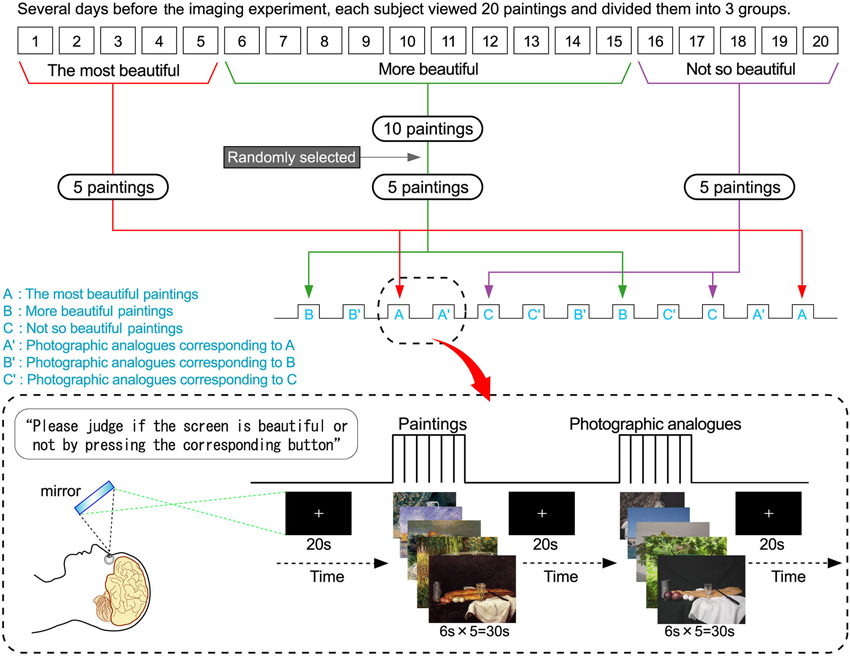
Figure 2. Protocol. Several days before imaging experiment, each subject slowly and carefully viewed 20 paintings which were still life and landscape by famous painters such as Cezanne, Monet and so on. They were divided into 3 groups consisting of 5 paintings of the most beautiful, 10 paintings of more beautiful, and 5 paintings of not so beautiful by each subject. Thereafter, 5 paintings of the 10 paintings of more beautiful were randomly selected by the researcher. This study was block-design and all blocks had a sequence of 5 screens which consisted of paintings or photographic analogs. In sum, 15 paintings (5 of the most beautiful, 5 of more beautiful, and 5 of not so beautiful) were used for the following imaging experiment. Three painting blocks were presented to the subjects comprising the most beautiful (block A), more beautiful (block B) and not so beautiful (block C) while another 3 photographic analog blocks labeled A’, B’, and C’ were presented that corresponded to (or imitated) block A, B, and C, respectively. These photographs (i.e., photographic analogs) were used as a control for the imaging experiment. Prior to each block, a fixation cross was presented for 20 s. The sequence of the presentation of the blocks was B, B’, A, A’, C, C’, B’, B, C’, C, A’, and A. Subjects were instructed as follows: “Please judge if the screen is beautiful or not by pressing the corresponding button”.
MRI
Functional MR images were collected using Siemens magnetom verio 3T MRI system. A time course series of 174 volumes was acquired with a T2-weighted single shot gradient echo planar imaging (EPI) sequence. Each volume consisted of 36 slices, with a slice thickness of 3 mm and a gap of 0.75 mm, and covered the almost the whole brain. Images were acquired in the axial plane (TR = 3000 ms; TE = 30 ms; FOV = 210 mm; voxel size = 3 × 3 × 3 mm). The total acquisition time was 10 min 8 s, including periods for signal equilibration. T1-weighted structural images were acquired with 3-D magnetization prepared rapid gradient echo (MPRAGE) in the sagittal plane (TR = 2040 ms; TE = 2.53 ms; TI = 900 ms; the flip angle was 9°; FOV = 192 mm; voxel size = 1 × 1 × 1 mm).
fMRI Data Analysis
All fMRI analysis was performed in SPM8 (Statistical Parametric Mapping software, University College of London, London, UK).1 Preprocessing (movement correction, normalization to the MNI EPI template, smoothing with an isotropic 8 mm FWHM kernel, and resampling to 2 mm cubic voxels) were performed first. Each individual data set was carefully screened for data quality via inspection for image artifacts and excessive head motion (>3 mm head motion or 2° head rotation).
In the first level analyses, we used following parameters: Interscan Interval 3 s, Microscan Resolution 36, and Microtime Onset 18. These values followed setting of MR acquisition. Each condition was modeled with a boxcar function and convoluted with a canonical hemodynamic response function. Low frequency drifts were removed using a temporal high-pass filter with a cutoff of 128 s. Serial autocorrelation was also corrected using AR (1) model. We created 6 beta images in each subject: most beautiful paintings, more beautiful paintings, not so beautiful paintings, most beautiful photographic analogs, more beautiful photographic analogs, not so beautiful photographic analogs.
The second level (random-effects) analyses using the full factorial module in SPM8. We performed analysis of variance (ANOVA) using visual sources (paintings and photographic analogs) and rating (most beautiful, more beautiful and not so beautiful) as factors using 6 beta images created in the first level. Statistical thresholds for full factorial analysis were set at p < 0.001 at voxel level (uncorrected), p < 0.05 at cluster level (family-wise error (FWE) corrected).
Results
During the fMRI experiment, subjects appreciated whether the painting or photographic analog was beautiful or not, again. In comparison with the pre-experimental appreciation, 83.6% of (pre-appreciated) the most beautiful paintings were appreciated as beautiful. Similarly, 64.1% of more beautiful paintings and 33.3% of not so beautiful paintings were appreciated as beautiful. Regarding photographic analogs, 68.9% of photographic analogs to the most beautiful paintings, 59.7% of photographic analogs to more beautiful paintings, and 39.7% of photographic analogs to not so beautiful paintings were appreciated as beautiful. There was no significant difference in the number of appreciation of beautiful between all paintings and all photographic analogs (χ2 = 1.86, p = 0.40). During the experiment appreciation, subjects appreciated the painting as beautiful (58.7%) and they appreciated the photographic analogs as beautiful (57.5%) with no significant difference. Nonetheless, the association between the pre-experimental appreciation and the experimental appreciation was significantly positive for both paintings and photographic analogs in all 39 subjects. Therefore, it seems likely that there was a substantially difference in the aesthetic impact (paintings > photographic analogs), but the way of question (beautiful or not in the experiment) could not draw the difference. In order to investigate this possibility, we compared the rankings of the most beautiful paintings and those of their corresponding photographic analogs. In the ranking method, “1” is the most beautiful and a lower ranking value means more beautiful. As a result, the mean of the rankings of the most beautiful paintings was 3.0 (SD = 1.4) and that of those of their corresponding photographic analogs was 6.9 (SD = 5.1) (t = −11.8, p < 0.0001). Therefore, there was a significant difference in the aesthetic impact (paintings > photographic analogs) in the pre-experimental setting.
Table 1 and Figure 3 show that various regions including bilateral cingulate gyrus and bilateral medial frontal gyrus were activated. The results of ANOVA were shown in Figure 4 respectively. Activated regions in both positive effect of painting and positive effect of photographic analogs were described in Table 2. The positive effect of aesthetic appreciation of all three painting contrasts versus corresponding all three photographic analog contrasts revealed activations in bilateral cuneus and left lingual gyrus. On the other hand, positive effect of aesthetic appreciation of all three photographic analog contrasts versus all three painting contrasts revealed other regions shown in Table 1. There was no significant association between the brain responses and subjective ratings.
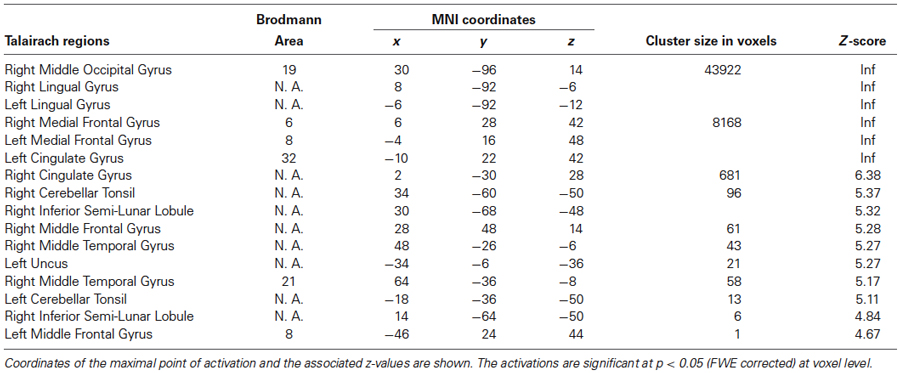
Table 1. Brain regions and coordinates of clusters and local maxima for aesthetic appreciation of paintings.
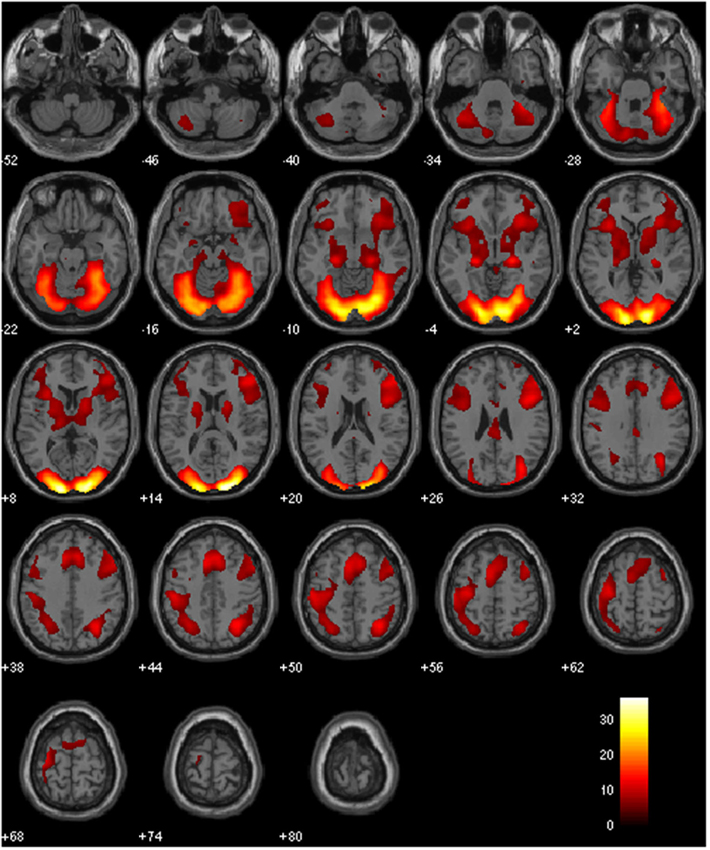
Figure 3. Various regions including bilateral cingulate gyrus and bilateral medial frontal gyrus were activated. The statistical significance refers to p < 0.05 (FWE corrected) at voxel level.
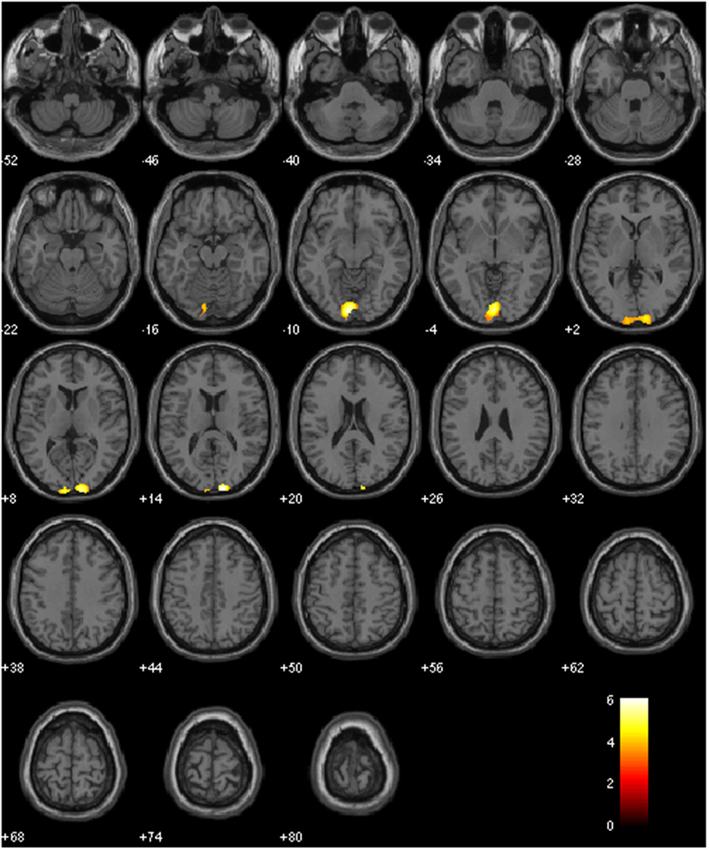
Figure 4. Activations in the contrast: aesthetic appreciation of all paintings > corresponding all photographic analogs. The comparison of aesthetic appreciation of 15 paintings versus corresponding 15 photographic analogs revealed activations in bilateral cuneus and left lingual gyrus, The statistical significance refers to p < 0.001 (uncorrected) at voxel level, p < 0.05 at cluster level (FWE corrected).

Table 2. Brain regions and coordinates of clusters and local maxima for positive effect of aesthetic appreciation of paintings versus photographic analogues.
Discussion
As aforementioned, perceived beauty of representational paintings may consist of the beauty of the motifs of the paintings plus the beauty of the paintings themselves, although, strictly speaking, the beauty may be modified by the use of the set of photographs of the artistic paintings for the presentation in fMRI. On the other hand, perceived beauty of photographic analogs may consist of the beauty of the motifs of the corresponding paintings plus the beauty of the photographs themselves. The present study could not measure each part, but perceived beauty of the paintings minus perceived beauty of the photographic analogs could have cancelled the beauty of the motifs and thereby estimated the beauty of the paintings themselves although the motifs of the photographic analogs were not completely the same as those of the paintings. In any case, the rate of beautiful appreciation was clearly decreased in line with the decrease of pre-appreciated beauty, indicating the validity of the present method to assess the appreciation of beauty of paintings.
Although during the experiment appreciation subjects appreciated the painting as beautiful (58.7%) and they appreciated the photographic analogs as beautiful (57.5%) with no significant difference, it seems likely that there was a substantially difference in the aesthetic impact (paintings > photographic analogs), but the way of question (beautiful or not in the experiment) could not draw the difference. In order to investigate this possibility, we compared the rankings of the most beautiful paintings and those of their corresponding photographic analogs. As a result, the mean of the rankings of the most beautiful paintings was 3.0 (SD = 1.4) and that of those of their corresponding photographic analogs was 6.9 (SD = 5.1) (t = −11.8, p < 0.0001). Therefore, there was a significant difference in the aesthetic impact (paintings > photographic analogs) in the pre-experimental setting. Taking the significantly positive association between the pre-experimental appreciation and the experimental appreciation, it seems likely that there was a significant difference in the aesthetic impact (paintings > photographic analogs) in the experimental setting.
Again, the purpose of the present study was to investigate the hypothesis that there exist specific neural correlates associated with the aesthetic appreciation for paintings. Therefore, we focused the comparison of aesthetic appreciation of paintings versus photographic analogs as a control. With regard to the comparison of aesthetic appreciation of 15 paintings versus 15 photographic analogs, bilateral cuneus and the left lingual gyrus were activated. These findings suggest that there exist specific neural correlates associated with the aesthetic appreciation for paintings and that they may be associated with bilateral cuneus and the left lingual gyrus.
Kawabata and Zeki (2004) showed that during aesthetical appreciation, paintings of landscapes produced activation in the anterior part of lingual gyrus, which is at least partly in accordance with our findings which revealed activation in the left lingual gyrus. Cupchik et al. (2009) revealed that the comparison of aesthetic appreciation (viewing representational paintings with aesthetic appreciation) versus baseline (viewing non-representational paintings without aesthetic or pragmatic appreciation) activated the bilateral insula (BA13) and bilateral occipital gyri (BA18/19) while the comparison of pragmatic appreciation versus baseline activated the right fusiform gyrus and bilateral occipital gyri (BA19) which is at least partly in accordance with our findings which revealed activation in bilateral cuneus (BA18) and the left lingual gyrus (BA18). Taken together, these studies suggest that bilateral cuneus and the left lingual gyrus may be neural correlates closely associated with aesthetic appreciation of paintings, which support our findings. With regard to the function of lingual gyrus, Chatterjee et al. (2009) argued that activation in this region represents its sensitivity to beauty, which is in line with the present findings.
Huang et al. (2011) proposed that the activation of brain networks including frontopolar cortex and right precuneus rather than a single cortical area in their paradigm supports the art scholar’s view that esthetic judgments are multi-faceted and multi-dimensional in nature. The present findings also suggest that in our paradigm perceived beauty of the artistic paintings may be associated with the brain network which may include various regions including bilateral cingulate gyrus and bilateral medial frontal gyrus (Figure 3 and Table 1) and specifically bilateral cuneus and left lingual gyrus (Figure 4 and Table 2) were activated.
One limitation is that the motifs were limited to still life and landscape of French late 19th century painters and excluded abstract paintings. Another limitation is methodological which contains a small number of blocks and order effects where paintings are always presented first. Moreover, it is unknown whether the block design is the best method. Also, aesthetic impact is not a unitary factor, being generated by fear, disgust, alarm as much as beauty or tranquility and these factors should have been considered as covariates in the analysis of our paradigm. Finally, the activation in what is termed the cuneus and lingual gyrus (Figure 4) corresponds to the foveal representation of the early visual areas, and may be interpreted as the expected fine-grain difference between the textural quality of the paintings versus the photographs. This textural difference cannot be completely differentiated from aesthetic. Further studied are required to generalize the present findings.
In conclusion, the present findings suggest a possibility that bilateral cuneus and the left lingual gyrus may be also closely associated with aesthetic appreciation of representational paintings.
Conflict of Interest Statement
The authors declare that the research was conducted in the absence of any commercial or financial relationships that could be construed as a potential conflict of interest.
Footnotes
References
Brown, S., Gao, X., Tisdelle, L., Eickhoff, S. B., and Liotti, M. (2011). Naturalizing aesthetics: brain areas for aesthetic appraisal across sensory modalities. Neuroimage 58, 250–258. doi: 10.1016/j.neuroimage.2011.06.012
Cela-Conde, C. J., Ayala, F. J., Munar, E., Maestú, F., Nadal, M., Capó, M. A., et al. (2009). Sex-related similarities and differences in the neural correlates of beauty. Proc. Natl. Acad. Sci. U S A 106, 3847–3852. doi: 10.1073/pnas.0900304106
Chatterjee, A., Thomas, A., Smith, S. E., and Aguirre, G. K. (2009). The neural response to facial attractiveness. Neuropsychology 23, 135–143. doi: 10.1037/a0014430
Cinzia, D. D., and Vittorio, G. (2009). Neuroaesthetics: a review. Curr. Opin. Neurobiol. 19, 682–687. doi: 10.1016/j.conb.2009.09.001
Cupchik, G. C., Vartanian, O., Crawley, A., and Mikulis, D. J. (2009). Viewing artworks: contributions of cognitive control and perceptual facilitation to aesthetic experience. Brain Cogn. 70, 84–91. doi: 10.1016/j.bandc.2009.01.003
Huang, M., Bridge, H., Kemp, M. J., and Parker, A. J. (2011). Human cortical activity evoked by the assignment of authenticity when viewing works of art. Front. Hum. Neurosci. 5:134. doi: 10.3389/fnhum.2011.00134
Ishizu, T., and Zeki, S. (2011). Toward a brain-based theory of beauty. PLoS One 6:e21852. doi: 10.1371/journal.pone.0021852
Kawabata, H., and Zeki, S. (2004). Neural correlates of beauty. J. Neurophysiol. 91, 1699–1705. doi: 10.1152/jn.00696.2003
Kirk, U. (2008). The neural basis of object-context relationships on aesthetic judgment. PLoS One 3:e3754. doi: 10.1371/journal.pone.0003754
Kirk, U., Skov, M., Christensen, M. S., and Nygaard, N. (2009a). Brain correlates of aesthetic expertise: a parametric fMRI study. Brain Cogn. 69, 306–315. doi: 10.1016/j.bandc.2008.08.004
Kirk, U., Skov, M., Hulme, O., Christensen, M. S., and Zeki, S. (2009b). Modulation of aesthetic value by semantic context: an fMRI study. Neuroimage 44, 1125–1132. doi: 10.1016/j.Neuroimage.2008.10.009
Lacey, S., Hagtvedt, H., Patrick, V. M., Anderson, A., Stilla, R., Deshpande, G., et al. (2011). Art for reward’s sake: visual art recruits the ventral striatum. Neuroimage 55, 420–433. doi: 10.1016/j.neuroimage.2010.11.027
Keywords: functional magnetic resonance imaging (fMRI), appreciation, beauty, oil painting, lingual gyrus, cuneus
Citation: Mizokami Y, Terao T, Hatano K, Hoaki N, Kohno K, Araki Y, Kodama K, Makino M, Izumi T, Shimomura T, Fujiki M and Kochiyama T (2014) Difference in brain activations during appreciating paintings and photographic analogs. Front. Hum. Neurosci. 8:478. doi: 10.3389/fnhum.2014.00478
Received: 18 December 2013; Accepted: 11 June 2014;
Published online: 07 July 2014.
Edited by:
Hans-Jochen Heinze, University of Magdeburg, GermanyReviewed by:
Bernd Weber, Rheinische Friedrich-Wilhelms-Universität Bonn, GermanyAndrew J. Parker, University of Oxford, UK
Copyright © 2014 Mizokami, Terao, Hatano, Hoaki, Kohno, Araki, Kodama, Makino, Izumi, Shimomura, Fujiki and Kochiyama. This is an open-access article distributed under the terms of the Creative Commons Attribution License (CC BY). The use, distribution or reproduction in other forums is permitted, provided the original author(s) or licensor are credited and that the original publication in this journal is cited, in accordance with accepted academic practice. No use, distribution or reproduction is permitted which does not comply with these terms.
*Correspondence: Takeshi Terao, Department of Neuropsychiatry, Faculty of Medicine, Oita University, Idaigaoka 1-1, Hasama-machi, Yufu City, Oita 879-5593, Japan e-mail:dGVyYW9Ab2l0YS11LmFjLmpw
 Yoshinori Mizokami
Yoshinori Mizokami Takeshi Terao
Takeshi Terao Koji Hatano
Koji Hatano Nobuhiko Hoaki1
Nobuhiko Hoaki1 Kentaro Kohno
Kentaro Kohno Tsuyoshi Shimomura
Tsuyoshi Shimomura Minoru Fujiki
Minoru Fujiki Takanori Kochiyama
Takanori Kochiyama